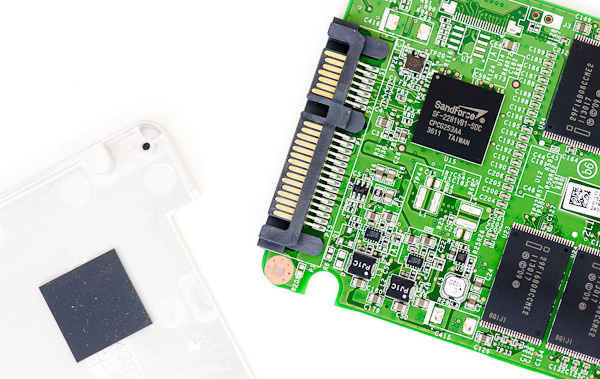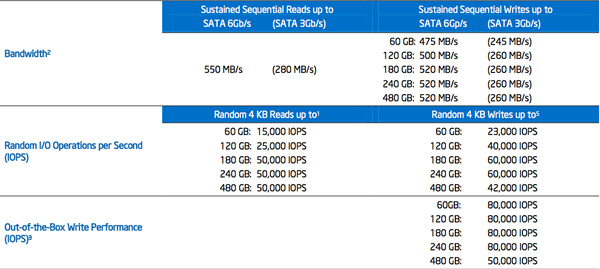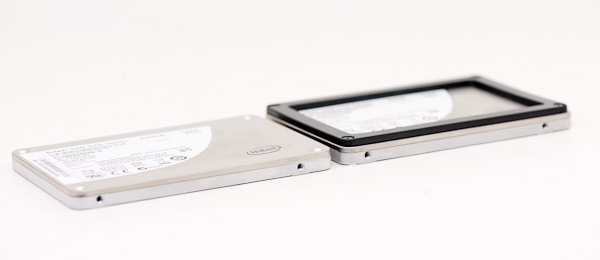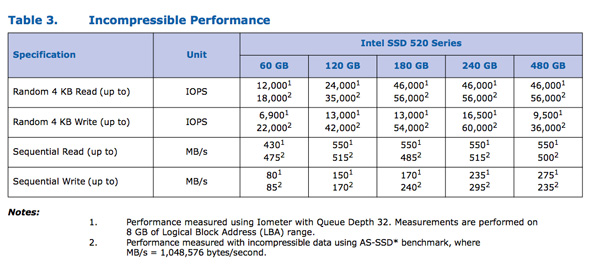Intel SSD 520 Review: Cherryville Brings Reliability to SandForce
by Anand Lal Shimpi on February 6, 2012 11:00 AM ESTThe Intel SSD 520
Intel sent us a 240GB and 60GB SSD 520 for review, but the performance specs of the entire family are in the table below:
The Intel SSD 520 is available in both 9.5mm and 7mm versions, with the exception of the 480GB flavor that only comes in a 9.5mm chassis. The 520's uses Intel's standard 7mm chassis with a 2.5mm removable plastic adapter that we've seen since the X25-M G2. The plastic adapter allows the drive to fit in bays designed for 9.5mm drives. Note that Intel doesn't ship shorter screws with the 9.5mm drives so you can't just remove the plastic adapter and re-use the existing screws if your system only accepts a 7mm drive.
Inside the drive we see the oh-so-familiar SandForce SF-2281 controller and Intel 25nm MLC NAND. The controller revision appears unchanged from other SF drives we've seen over the past year. The PCB design is unique to the 520, making it and the custom Intel firmware the two noticeable differences between this and other SF-2281 drives.

Intel uses the metal drive chassis as a heatsink for the SF-2281 controller
The SF-2281 Controller
I've explained how the SF-2281 works in the past, but for those of you who aren't familiar with the technology I'll provide a quick recap. Tracking the location of data written to an SSD ends up being one of the most difficult things a controller has to do. There are a number of requirements that must be met. Data can't be written to the same NAND cells too frequently and it should be spread out across as many different NAND die as possible (to improve performance). For large sequential transfers, meeting these (and other) requirements isn't difficult. Problems arise when you've got short bursts of random data that can't be combined. The end result is leaving the drive in a highly fragmented state that is suboptimal for achieving good performance.
You can get around the issue of tracking tons of data by simply not allowing small groups of data to be written. Track data at the block level, always requiring large writes, and your controller has a much easier job. Unfortunately block mapping results in very poor small file random write performance as we've seen in earlier architectures so this approach isn't very useful for anything outside of CF/SD cards for use in cameras.
A controller can rise to the challenge by having large amounts of cache (on-die and externally) to help deal with managing huge NAND mapping tables. Combine tons of fast storage with a fast controller and intelligent firmware and you've got a good chance of building a high performance SSD.

SandForce's solution leverages the work smart not hard philosophy. SF controllers reduce the amount of data that has to be tracked on NAND by compressing any data the host asks to write to the drive. From the host's perspective, the drive wrote everything that was asked of it, but from the SSD's perspective only the simplest representation of the data is stored on the drive. Running real-time compression/de-duplication algorithms in hardware isn't very difficult and the result is great performance for a majority of workloads (you can't really write faster than a controller that doesn't actually write all of the data to NAND). The only limit to SandForce's technology is that any data that can't be compressed (highly random bits or data that's already compressed) isn't written nearly as quickly.
Intel does a great job of spelling out the differences in performance depending on the type of data you write to the SSD 520, but it's something that customers of previous Intel SSDs haven't had to worry about. Most client users stand to benefit from SandForce's technology and it's actually very exciting for a lot of enterprise workloads as well, but you do need to pay attention to what you're going to be doing with the drive before deciding on it.
The Intel SSD Toolbox
The Intel SSD 520 works flawlessly with the latest version of Intel's SSD Toolbox. The toolbox allows you to secure erase the drive from within Windows, and it also allows you to perform firmware updates and pull SMART info from the drive. Unlike other SandForce toolboxes, Intel's software works fine with Intel's RST drivers installed.

The Test
| CPU | Intel Core i7 2600K running at 3.4GHz (Turbo & EIST Disabled) - for AT SB 2011, AS SSD & ATTO |
| Motherboard: | Intel DH67BL Motherboard |
| Chipset: | Intel H67 |
| Chipset Drivers: | Intel 9.1.1.1015 + Intel RST 10.2 |
| Memory: | Corsair Vengeance DDR3-1333 2 x 2GB (7-7-7-20) |
| Video Card: | eVGA GeForce GTX 285 |
| Video Drivers: | NVIDIA ForceWare 190.38 64-bit |
| Desktop Resolution: | 1920 x 1200 |
| OS: | Windows 7 x64 |























138 Comments
View All Comments
vanteo - Thursday, May 31, 2012 - link
I got a 520 120 GB for my Lenovo W520 a week ago ($187). I experienced a few freezes (mouse still movable but the HD light stuck on and I couldn't actually DO anything), and long stutters (5 sec < n < 1 min) while setting it up shortly after Windows 7 64-bit install. It came with the 400i firmware, which was still the latest. As I used it more, the freezes have stopped and the stutters seem to have all but disappeared. I did install Intel's latest Rapid Storage Technology drivers at some point, so perhaps that helped. Otherwise, very fast and I'm pleased.vanteo - Thursday, May 31, 2012 - link
I should clarify that the problems were during normal operation. They had nothing to do with hibernate, standby, or resume.vanteo - Thursday, August 23, 2012 - link
Update: I'm still running into these hangs regularly, actually. I followed some advice to change some advanced Hard disk power options (LMP), but that had no effect. Either it's a bad drive, or there's some system incompatibility with the Lenovo ThinkPad W520.kzinti - Thursday, May 31, 2012 - link
Just following up on my April 18 post... I am still running the replaced 520 SSD as my OS and everything runs smoothly. Haven't run into a single BSOD or hiccup / slowdown. I use my computer 4h+ a day.jfgreen - Monday, September 17, 2012 - link
This drive has some serious issues this was my post in Intel Support Community:Last Thursday I received my brand new Dell Precision M6600. Before I started to use the system I upgraded the hard drive to an Intel 520 Series..
After dropping in the SSD, I was ready to install Windows 7 Pro. I first went into the BIOS and left the setting on RAID. After reading tons of forums, this seemed like the right way on installing the hard drive. Once complete I installed all the necessary drivers (which is a story in its self!). After, I went on the Intel website and ran the driver utility make sure everything is up-to-date. I also installed the SSD toolbox to optimize the drive.
After dealing with the BIOS not always detecting the SSD and the occasional OS freeze, I made my way into the Intel control panel. I noticed the hard drive was only running at 3GB/s, I thought that was kind of odd since the computer is capable of running 6GB/s. I decided to change the BIOS to AHCI and reinstall 7..
Once complete, I still had to deal with the BIOS not detecting the SSD and 7 freezing up, every so often. Anywho, once I re-installed all drivers and utilities. I now see the hard drive running at 6GB/s. I was a happy camper until I started to use the computer. I noticed it freezed up the more I use it.
Intel (typing this while simultaneously shaking my pointer finger) you have a serious issue with your SSD. You need to post a firmware update. Not only to fix the issue with 7 but, also for folks who have M6600 and other affected laptop/desktops; who decide to buy your SSD.
nextel2010 - Saturday, September 29, 2012 - link
I hear you. I purchased three Intel 520's and installed them in three systems known to be stable. One works well, one had intermittent freezes, and the last would freeze and BSOD several times a day, regularly. This last one also had problems being recognized by the BIOS during installation, and would intermittently drop off the system afterwards.I researched the issue, and found a whole lot of suggested fixes, but no general patterns to a solution. In an effort to troubleshoot the last system, I replaced the 520 with an old OCZ Core II, purchased in early 2009. The OCZ was recognized immediately by the BIOS, and installed easily. It ran perfectly, if a bit slower, up to the present time (more than a month).
i don't have time to troubleshoot the two nonworking systems, which are mission-critical and needed to be operational, so I returned the two troublesome 520's and replaced them with Samsung 830's. The Samsungs are lifesavers. They work perfectly, are every bit as fast as the Intels and, most importantly, are rock stable. I couldn't be happier with them or recommend them more. Adding even more value is the fact that the Samsungs were less expensive than the 520's.
I initially went with the Intel because of their five-year warranty and reputation for reliability, but to me at least, it doesn't appear that they have been able to iron out the issues with the SF-2281. To date, no firmware update had been released. A longer warranty for a troublesome drive is pointless. A lot of users have had no issues with the 520's, but a good number still encounter problems. If it was my own system and time wasn't an issue, I wouldn't mind tinkering and troubleshooting, but under the circumstances, I simply went with the solution that works.
toncij - Sunday, September 30, 2012 - link
It is a nice review, but what bothers me is:"Intel did go on record saying that the 520 is expected to have far fewer F4/F7 BSODs than any other SF-2281 drive. I asked Intel if I should read into the phrase "far fewer", but the answer was no - the 520 is expected to have similar reliability to the Intel SSD 510 and 320."
Since I've experienced 320 series and would never go back there, I wonder why intel avoids to say "NO BSODs" - I'm not particullary fond of "far fewer BSOD's" and I prefer zero of those.
I'm looking for the best SSD I can get, but with stability and reliability being a primary variable to look at. I've noticed people praise SM 830 drivers, but these seem much slower than 520 and still quite power-hungry at idle and load, which pretty much is not what I'd like to put into my ultraportable.
Is Intel still prone to BSODs and how good it really is compared to SM830?
sarangiman - Friday, October 12, 2012 - link
Not sure why this article mentions that the 480GB drive is only available with a 9.5mm chassis.If you remove the black spacer, it's 7mm (well, 6.5mm as measured by my caliper).
Albeit, I just bought the drive this week (10.2012); was this 480GB drive originally 9.5mm but now they're shipping 7mm chassis + black spacer?
If one could find short screws for the 7mm chassis, I don't see why one couldn't use the 480GB drive in form factors requiring 7mm drives...